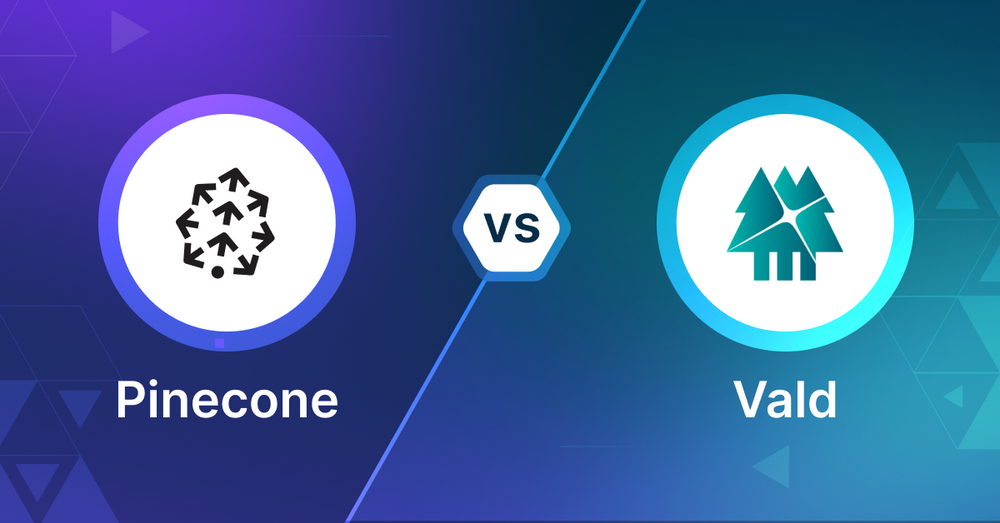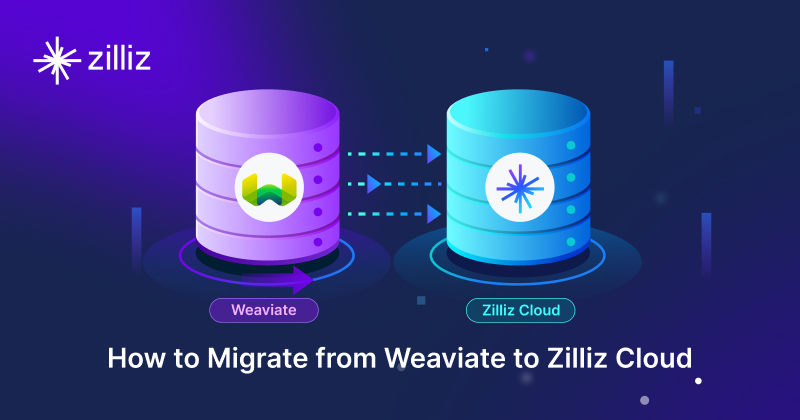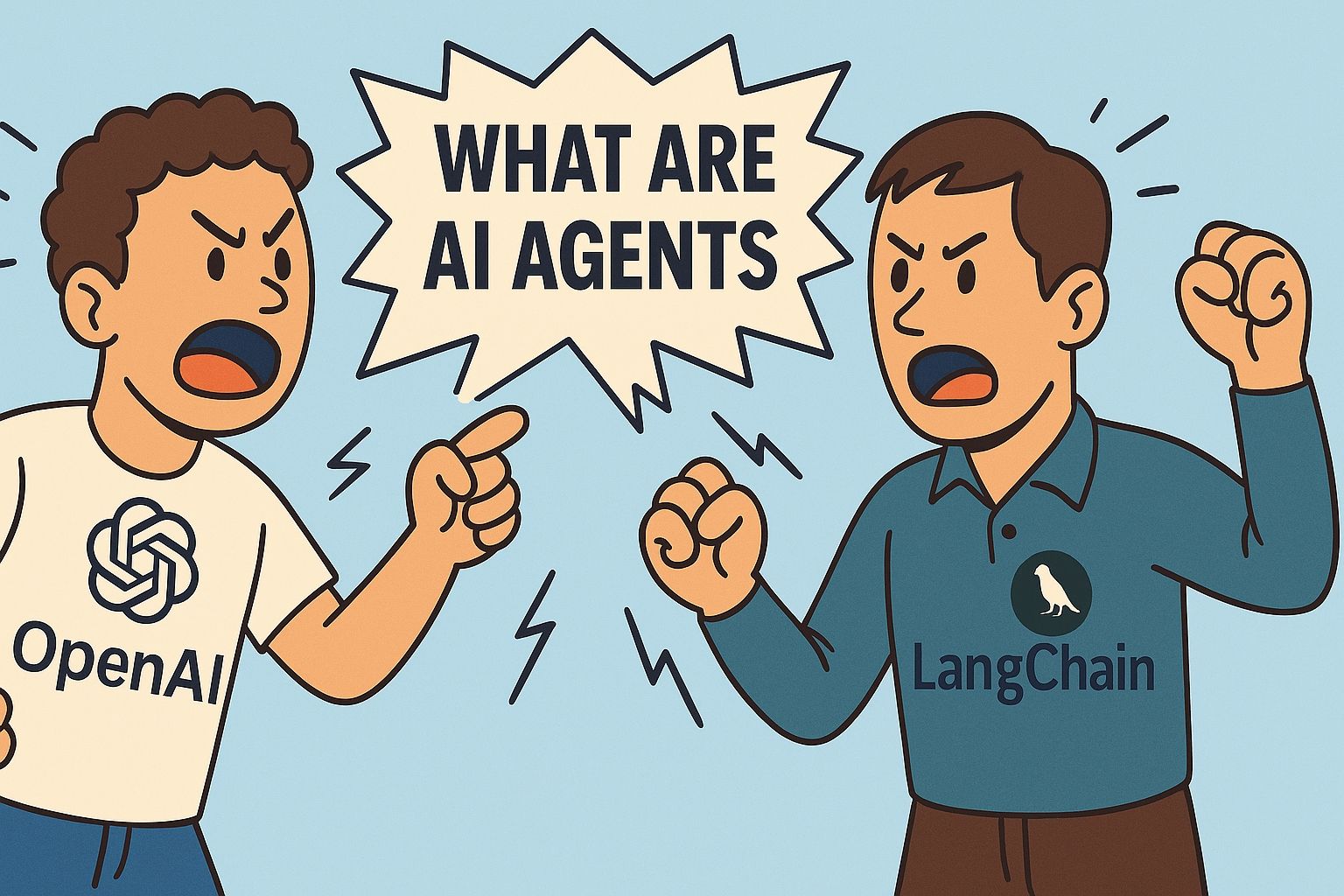Pinecone vs Vald: Selecting the Right Database for GenAI Applications

As AI-driven applications evolve, the importance of vector search capabilities in supporting these advancements cannot be overstated. This blog post will discuss two prominent databases with vector search capabilities: Pinecone and Vald. Each provides robust capabilities for handling vector search, an essential feature for applications such as recommendation engines, image retrieval, and semantic search. Our goal is to provide developers and engineers with a clear comparison, aiding in the decision of which database best aligns with their specific requirements.
What is a Vector Database?
Before we compare Pinecone vs Vald, let's first explore the concept of vector databases.
A vector database is specifically designed to store and query high-dimensional vectors, which are numerical representations of unstructured data. These vectors encode complex information, such as the semantic meaning of text, the visual features of images, or product attributes. By enabling efficient similarity searches, vector databases play a pivotal role in AI applications, allowing for more advanced data analysis and retrieval.
Common use cases for vector databases include e-commerce product recommendations, content discovery platforms, anomaly detection in cybersecurity, medical image analysis, and natural language processing (NLP) tasks. They also play a crucial role in Retrieval Augmented Generation (RAG), a technique that enhances the performance of large language models (LLMs) by providing external knowledge to reduce issues like AI hallucinations.
There are many types of vector databases available in the market, including:
- Purpose-built vector databases such as Milvus, Zilliz Cloud (fully managed Milvus)
- Vector search libraries such as Faiss and Annoy.
- Lightweight vector databases such as Chroma and Milvus Lite.
- Traditional databases with vector search add-ons capable of performing small-scale vector searches.
Pinecone and Vald are purpose-built vector databases. This post compares their vector search capabilities.
Pinecone: The Basics
Pinecone is a SaaS built for vector search in machine learning applications. As a managed service, Pinecone handles the infrastructure so you can focus on building applications not databases. It’s a scalable platform for storing and querying large amounts of vector embeddings for tasks like semantic search and recommendation systems.
Key features of Pinecone include real-time updates, machine learning model compatibility and a proprietary indexing technique that makes vector search fast even with billions of vectors. Namespaces allow you to divide records within an index for faster queries and multitenancy. Pinecone also supports metadata filtering, so you can add context to each record and filter search results for speed and relevance.
Pinecone’s serverless offering makes database management easy and includes efficient data ingestion methods. One of the features is the ability to import data from object storage, which is very cost effective for large scale data ingestion. This uses an asynchronous long running operation to import and index data stored as Parquet files.
To improve search Pinecone hosts the multilanguage-e5-large model for vector generation and has a two stage retrieval process with reranking using the bge-reranker-v2-m3 model. Pinecone also supports hybrid search which combines dense and sparse vector embeddings to balance semantic understanding with keyword matching. With integration into popular machine learning frameworks, multiple language support and auto scaling Pinecone is a complete solution for vector search in AI applications with both performance and ease of use.
Vald: The Basics
Vald is a powerful tool for searching through huge amounts of vector data really fast. It's built to handle billions of vectors and can easily grow as your needs get bigger. The cool thing about Vald is that it uses a super quick algorithm called NGT to find similar vectors.
One of Vald's best features is how it handles indexing. Usually, when you're building an index, everything has to stop. But Vald is smart - it spreads the index across different machines, so searches can keep happening even while the index is being updated. Plus, Vald automatically backs up your index data, so you don't have to worry about losing everything if something goes wrong.
Vald is great at fitting into different setups. You can customize how data goes in and out, making it work well with gRPC. It's also built to run smoothly in the cloud, so you can easily add more computing power or memory when you need it. Vald spreads your data across multiple machines, which helps it handle huge amounts of information.
Another neat trick Vald has is index replication. It stores copies of each index on different machines. This means if one machine has a problem, your searches can still work fine. Vald automatically balances these copies, so you don't have to worry about it. All of this makes Vald a solid choice for developers who need to search through tons of vector data quickly and reliably.
Key Differences
When choosing a vector search tool, Pinecone and Vald are two to consider. Both can handle large scale vector data but have different features that may make one more suitable for you. Let’s compare them across several areas to help you decide.
Search Methodology
Pinecone uses custom indexing for fast vector search even with billions of vectors. Supports real-time updates and has namespace division for faster queries.
Vald uses the NGT (Neighborhood Graph and Tree) algorithm for fast approximate nearest neighbor search. It distributes the index across multiple machines for concurrent search and updates.
Data Handling
Pinecone is great for vector embeddings for machine learning applications. It has metadata filtering so you can add context to each record and refine search results.
Vald is designed for billions of vectors. Has flexible data input/output customization so it can adapt to any data structure.
Scalability and Performance
Pinecone has auto-scaling and is built for large datasets. Serverless architecture handles infrastructure scaling for you.
Vald distributes data across multiple machines for horizontal scaling. Designed for cloud so you can easily add resources as you need.
Flexibility and Customization
Pinecone integrates with popular machine learning frameworks and supports multiple languages. Has hybrid search for dense and sparse vector embeddings.
Vald has customizable data input/output processes and works with gRPC. Distributed architecture gives you flexibility in deployment and scaling.
Integration and Ecosystem
Pinecone integrates with machine learning ecosystems and has SDKs for multiple languages. Has built-in models for vector generation and reranking.
Vald is designed for cloud and has gRPC integration, so it can adapt to any tech stack.
Ease of Use
Pinecone, as a managed service, handles infrastructure management so developers can focus on application building. Has efficient data ingestion methods, including importing from object storage.
Vald requires more hands-on management but has fine grained control over the system. Has automatic index backup and replication management.
Cost
Pinecone is SaaS so may be more cost effective for teams that don’t want to manage infrastructure.
Vald is open-source, so it may be a lower cost but would require more resources for setup and maintenance.
Security
Pinecone as a managed service likely has built-in security but would need to check their documentation for details.
Vald security is up to you and your infrastructure.
When to Use Each
Pinecone is the choice when you want a fully managed vector database that integrates with machine learning workflows. It’s great for applications that need real-time vector search at scale, like recommendation systems, semantic search engines or AI powered chatbots. Pinecone is good when you want to focus on your application and not the infrastructure, especially when working with large datasets and need hybrid search or metadata filtering.
Vald is the choice when you want more control over your vector search implementation and have the resources to manage your own infrastructure. It’s good for projects that need a highly customisable solution, especially those in cloud environments with specific performance or scaling requirements. Vald is good when you need to handle billions of vectors, need fine grained control over indexing and search or want to integrate vector search with your existing systems using gRPC.
Summary
Pinecone and Vald both have vector search solutions, each with its own strengths. Pinecone is a managed service with strong machine learning integration, real-time updates and features like hybrid search and metadata filtering. It’s designed for ease of use and scalability so it’s good for teams that want to focus on application development. Vald is highly customisable, can handle billions of vectors and has a distributed architecture that allows concurrent indexing and searching. Your choice between the two should be based on your use case, data volume, level of control required, resources for infrastructure management and integration with existing systems. Consider the size of your data, complexity of your search requirements, your team’s expertise and long term scaling plans when making your decision.
Read this to get an overview of Pinecone and Vald but to evaluate these you need to evaluate based on your use case. One tool that can help with that is VectorDBBench, an open-source benchmarking tool for vector database comparison. In the end, thorough benchmarking with your own datasets and query patterns will be key to making a decision between these two powerful but different approaches to vector search in distributed database systems.
Using Open-source VectorDBBench to Evaluate and Compare Vector Databases on Your Own
VectorDBBench is an open-source benchmarking tool for users who need high-performance data storage and retrieval systems, especially vector databases. This tool allows users to test and compare different vector database systems like Milvus and Zilliz Cloud (the managed Milvus) using their own datasets and find the one that fits their use cases. With VectorDBBench, users can make decisions based on actual vector database performance rather than marketing claims or hearsay.
VectorDBBench is written in Python and licensed under the MIT open-source license, meaning anyone can freely use, modify, and distribute it. The tool is actively maintained by a community of developers committed to improving its features and performance.
Download VectorDBBench from its GitHub repository to reproduce our benchmark results or obtain performance results on your own datasets.
Take a quick look at the performance of mainstream vector databases on the VectorDBBench Leaderboard.
Read the following blogs to learn more about vector database evaluation.
Further Resources about VectorDB, GenAI, and ML
- What is a Vector Database?
- Pinecone: The Basics
- Vald: The Basics
- Key Differences
- When to Use Each
- Summary
- Using Open-source VectorDBBench to Evaluate and Compare Vector Databases on Your Own
- Further Resources about VectorDB, GenAI, and ML
Content
Start Free, Scale Easily
Try the fully-managed vector database built for your GenAI applications.
Try Zilliz Cloud for FreeKeep Reading

Why Teams Are Migrating from Weaviate to Zilliz Cloud — and How to Do It Seamlessly
Explore how Milvus scales for large datasets and complex queries with advanced features, and discover how to migrate from Weaviate to Zilliz Cloud.

Zilliz Cloud Now Available in Azure North Europe: Bringing AI-Powered Vector Search Closer to European Customers
The addition of the Azure North Europe (Ireland) region further expands our global footprint to better serve our European customers.

What Exactly Are AI Agents? Why OpenAI and LangChain Are Fighting Over Their Definition?
AI agents are software programs powered by artificial intelligence that can perceive their environment, make decisions, and take actions to achieve a goal—often autonomously.
The Definitive Guide to Choosing a Vector Database
Overwhelmed by all the options? Learn key features to look for & how to evaluate with your own data. Choose with confidence.